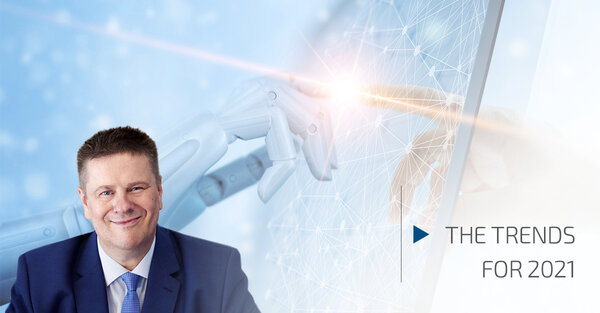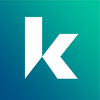
At the beginning of the year, Hannes Niederhauser, CEO of S&T AG, gives an outlook on the trends that await us in the industrial environment this year, in a conversation with the blog editors.
Corona was the dominant topic in 2020. What impact do you think the pandemic had on the industrial environment?
Hannes Niederhauser: Corona has changed the world and given a boost to digitalization in many areas. This is particularly evident in the industrial environment. Processes around production have also changed. We see a trend from off-shoring to Asia back to in-shoring to Europe. This shortens supply chains and creates more proximity to partners. However, competitive production in Europe requires a high degree of automation. This requires state-of-the-art technologies.
By 2025, around 75,000 million machines will be integrated into the Internet of Things (IoT) and the Industrial Internet of Things (IIoT). The leading market research institutes forecast annual growth of 31%. Due to this development, gigantic amounts of data are being generated around the globe. These must be evaluated and distributed reliably as well as quickly and securely. Kontron, who is responsible for IoT Solutions within the S&T Group, has already set the course for corresponding solutions with the development of numerous key technologies.
Which trends do you consider to be particularly formative for 2021 and beyond?
Hannes Niederhauser: In some areas we will see rapid developments in the coming months. These include the further expansion of 5G networks, the increasing use of Artificial Intelligence, Machine Vision, Machine/Deep Learning, and intelligent Edge Computing, as well as a multitude of new applications around Industry 4.0, in transportation, medical technology and system-relevant infrastructure. Regarding HPC (High Performance Computing) topics, the new COM-HPC® standard will become the basis for the development of innovative applications in the IoT/Embedded area.
What will Kontron focus on in particular?
Hannes Niederhauser: In 2021, we will focus, among other things, on further supporting small and medium-sized enterprises. Our goal is to develop current megatrends into practical, optimized solutions for our customers and to demonstrate their concrete benefits. The boundaries between hardware, software, cloud, and edge are increasingly fading. In contrast, the focus shifts to the user perspective. We support SMEs in their strategic orientation, the consistency of applications and, last but not least, the feasibility of solutions in the ecosystem of the respective company. To this end, we offer everything for digital transformation within the SUSiEtec portfolio, from consulting to HW/SW bundles, system integration, SW development, hybrid cloud - up to installation and maintenance. Together with our customers, we will develop case-oriented solutions and realize what is technologically feasible.
Which areas do you think will be particularly shaped by digitalisation?
Hannes Niederhauser: Digitalization is also becoming increasingly prevalent in the service sector. Predictive maintenance, i.e. the anticipatory maintenance of components, coupled with automatic and coordinated deployment plans, enable new business models. We offer suitable tools for this, such as SUSiEtec Workforce, to digitally control the deployment of service teams; or the Equipment Cloud as part of SUSiEtec, in which all hardware and software versions for service purposes are stored and can be accessed at any time. This optimizes collaboration at all levels - from person to person as well as from machine to machine or from person to machine. This means that all relevant information is available on any end device, regardless of location, remotely and around the clock. This improves customer service and has a positive effect on customer loyalty.
Which trend themes from last year will remain?
Hannes Niederhauser: The trend topic HPC (High Performance Computing) in the embedded edge computing sector will continue to accompany us in 2021. With the new COM-HPC® standard, an extensive range of solutions can be realized in the future which require the highest computing power, large storage capacities and high bandwidths. The broad spectrum of applications ranges from edge servers, AI/ML/DL solutions in industry, stationary testers, and mobile measuring devices to mobile edge computing for LTE/5G networks and rugged computers for autonomous vehicles such as shuttle buses, taxis, or vehicles in the agricultural and heavy-duty sector, which will be networked with GPS and AI functionality via 5G. For this purpose, we are planning the first COM-HPC® server modules with server-class processors for the second half of 2021. The highest computing power for the virtualization and consolidation of applications, as well as the acceleration of computing operations for Artificial Intelligence, are also provided by the new industrial Kontron modules, boards, and systems, which can be connected in real-time using TSN (Time Sensitive Networking). We see OPC UA over TSN being an open, cross-industry and manufacturer-independent standard as an essential basis for successful digitalization in the factory.
What do you expect from the new mobile communications standard 5G?
Hannes Niederhauser: The new mobile communications standard 5G enables enormous bandwidths, real-time applications, and a large number of participants; not to forget the high security factor. With 5G, private networks can also be realized, e.g. in smart factories. 5G networks are highly scalable and extremely adaptable. In private industrial networks, a wireless backbone can be realized with this new mobile radio standard, for example to securely network flexible manufacturing cells, robots and AGVs. Kontron has a large technology pool in the area of "Mission Critical Communication" and can build on the many years of experience of its communication teams and use synergies for the further adaptation of 5G. Fields of application for 5G networks are also the wireless control and monitoring of machines and devices in industrial environments with lowest latency, e.g. in connection with TSN and OPC UA. In the area of public safety and emergency services, 5G technology will become the platform for reliable, real-time communication; here, too, the communication specialists within the group have years of experience.
SNS Telecom forecasts the residential LTE and 5G market to grow at a CAGR of 19% between 2020 and 2023. We expect this trend to continue until 2030.
The pandemic has significantly increased the trend towards home office and remote learning around the globe. Analogously, the need for high-speed connections is increasing. We therefore expect investments in upgrading the broadband access network to 10G PON (Passive Optical Network) solutions to increase in the coming months. Numerous communications service providers have already started upgrading their optical access networks to 10 Gigabit in 2020 and Kontron is already supporting several projects here. According to Omdia Research, further strong growth can be expected from 2021 onwards. Therefore, 10G-PON will become the dominant new fixed broadband access technology within the next 2 years.
What is happening at Kontron about safety in the industrial environment?
Hannes Niederhauser: IoT, IIoT and Industry 4.0 applications are becoming increasingly complex due to rapid market developments. This makes the role of FuSa (Functional Safety) more crucial in the future. In industrial environments, the identification and evaluation of risks are essential. With individual solutions, errors can be avoided and dangerous system failures prevented. This ensures the protection of people, but also prevents damage to property. To ensure a wide range of safety functions for different fields of application, Kontron is developing its own hardware-based "FuSa-ready" products, which should be available by the end of 2021.
Medical technology is a growth segment. What plans has Kontron in this area?
Hannes Niederhauser: In medical technology, the SDC (Service-Oriented Device Connectivity) protocol will play a central role in the future. Kontron plans to support its own products for the medical sector with SDC as part of its membership in the OR.NET e.V.. The SDC standard ensures the fundamental interoperability of medical devices. This makes it possible to dynamically find compatible networking partners in distributed systems and ensures standardized and secure data exchange. Complex equipment parks and the digitalization of hospital processes are a challenge for staff. Often interoperability of systems is not given, which makes data exchange difficult. SDC creates new options to support this lack of interoperability. This improves clinical processes and increases patient safety.
How do you look forward to 2021 from Kontron's /S&T´s point of view?
Niederhauser: 2021 will be an exciting year from a technological perspective. The pandemic will probably stay with us for a while and will continue to drive digitalization in many areas. As a global, diversified and financially strong and innovative, reliable partner, we are ideally positioned to accompany our customers with their digital transformation. New applications will change processes and make them more secure. Standards simplify communication between devices and between man and machine. We will all benefit from this.
Thank you very much for the interview and this detailed outlook on 2021.


{{comment.comment}}